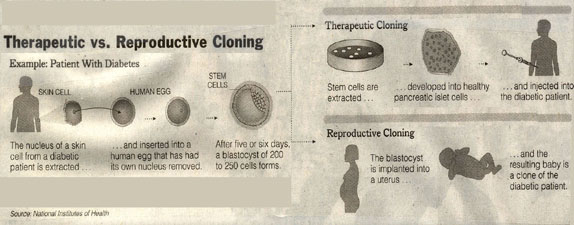Therapeutic Cloning of Human Embryonic Stem Cells
By surgically transplanting embryonic stem cells, scientists have performed the remarkable feat of repairing disabled body tissues in mice. The basic strategy for repairing damaged tissues is to surgically transfer embryonic stem cells to the damaged area, where the stem cells can form healthy replacement cells. Stem cells transferred into mouse heart muscle develop into heart muscle cells, replacing cells dead from heart attack. Stem cells transferred into a mouse brain form neurons, offering hope they we will eventually learn to use embryonic stem cells to repair spinal injury. Embryonic stem cells of mice have been induced to become insulin-secreting pancreas cells. The new cells produce only about 2% as much insulin as normal cells do, so there is still plenty to learn, but the take-home message is clear: transplanted embryonic stem cells offer a path to cure type 1 diabetes.
While exciting, these advances in stem cell research were all done in strains of mice without functioning immune systems. This prevents the mice from rejecting transplanted stem cells as foreign. A human with a normal immune system might well refuse to accept transplanted stem cells, simply because they are from another individual.
In 2001 a research team at the Rockefeller University reported a way around this potentially serious problem. Their solution? They isolate skin cells, then using the same procedure that created Dolly, they create an embryo from them.
First they remove the nucleus from the skin cell, and then they insert it into an egg whose nucleus has already been removed. The egg with its skin cell nucleus is allowed to form a 120-cell embryo. The embryo is then destroyed, its cells used as embryonic stem cells for transfer to injured tissue.
Using this procedure, called therapeutic cloning, the researchers succeeded in making cells from the tail of a mouse convert into the dopamine-producing cells of the brain that are lost in Parkinsons disease (figure 48.7).
Therapeutic cloning successfully addresses the key problem that must be solved before stem cells can be used to repair human tissues damaged by heart attack, nerve injury, diabetes, or Parkinsons, which is immune acceptance. In theraputic cloning, the body readily accepts stem cells because they are cloned from its own tissues, and so pass the immune systems self identity check.
The mouse experiment carried out by the Rockefeller researchers would have been far more controversial if it had been carried out in humans, because the 120-cell embryo could in principle be brought to term by inserting it into a human uterus.
Therapeutic cloning involves initiating balstocyst development from a patients tissue using nuclear transplant procedures, then using these embryonic stem cells to replace the patients damaged or lost tissue.
